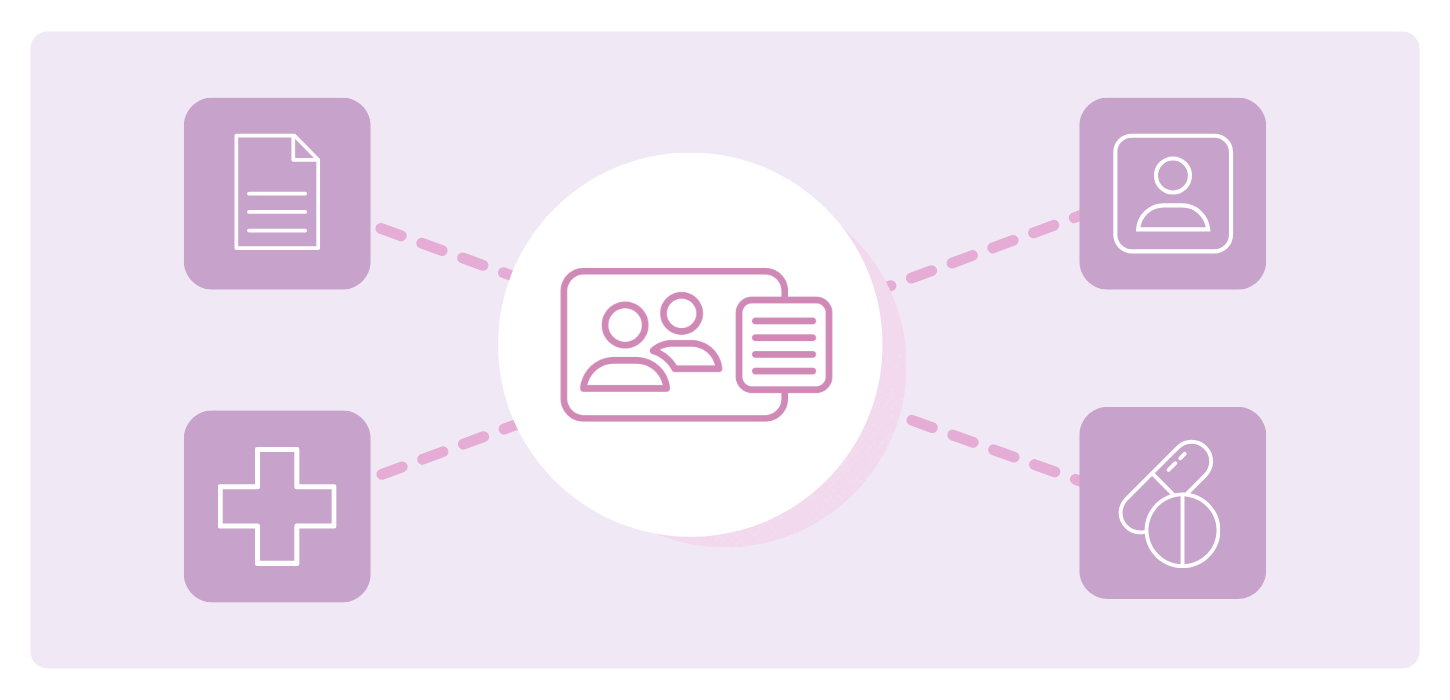At A Glance
Identity resolution unifies fragmented IDs into complete customer profiles, helping companies understand their audiences and deliver personalized, privacy-compliant experiences in a cookie-light world. With Experian’s AI-powered identity resolution solution, marketers gain the scale, accuracy, and compliance to compete while making marketing more human.In this article…
Every marketer has seen it: a customer browses reviews on a laptop, adds items to a cart on mobile, then “disappears.” In reality, they just likely switched devices or logged in with a different email. Identity resolution connects these scattered signals into a single profile so you never lose sight of the customer journey.
Identity resolution is what helps you keep track of customers who bounce around.
Connecting scattered signals into a single customer profile can help you deliver seamless experiences, meet strengthening privacy standards, turn first-party data into measurable results, and fuel better customer analytics.
See our identity resolution solution in action
What is identity resolution?
Identity resolution is the process of pulling together the different identifiers a customer uses and connecting them to a single profile. Without it, you’re left with an incomplete picture of the customer — like a cart tied to one email, an app login tied to another device, or a loyalty swipe that never links back to the same person.

Common identifiers include:
- Cookies: Short-lived browser data
- Emails: Plain-text and hashed
- Device IDs: Mobile advertising IDs (MAIDs) or app-based identifiers
- Loyalty IDs: Program numbers that tie online and offline activity
- Hashed PII: Personally identifiable information (PII) encrypted for privacy
Ultimately, identity resolution can help you recognize the same customer wherever they engage.
Why does identity resolution matter now?
Marketers face incomplete views, data silos, privacy regulations, and shrinking visibility:
- Rising consumer expectations: People want seamless, personalized journeys across touchpoints.
- Privacy-first environment: Consumer privacy legislation (like the GDPR, CCPA, GLBA, FCRA, and new state laws) makes compliance non-negotiable.
- Signal loss: The decline of cookies, MAIDs, and walled gardens are pushing brands toward first-party data.
Experian utilizes AI and machine learning to fill these gaps, predict behaviors, and connect signals across devices — providing marketers with a clear, privacy-safe view of their customers, even when traditional identifiers are missing.
In this environment, identity resolution matters because it gives marketers a way to deliver seamless, personalized customer experiences and engage audiences effectively while respecting their privacy. It’s the basis for turning consented first-party data into measurable marketing outcomes without sacrificing trust.
Why is identity resolution critical in a privacy-first world?
Even as cookies linger, marketers have already shifted their strategies to rely on first-party data, where choice and transparency are the baseline expectation. At Experian, our long history as a regulated data steward makes us a uniquely capable and trusted partner for managing modern compliance expectations. Our identity resolution solutions maximize the value of permission-based data while meeting consumer demand for privacy, personalization, and control.
Struggling with scattered customer data? Experian makes identity resolution seamless
How does identity resolution help brands?
Identity resolution turns fragmented signals into unified profiles that drive personalization, efficiency, and compliance. Here’s how it creates measurable business impact.
Creates a unified customer view
One of the biggest advantages of identity resolution is the ability to integrate data from loyalty programs, point-of-sale (POS) systems, customer relationship management (CRM) platforms, web analytics, and offline sources into a single, comprehensive profile. Experian strengthens identity resolution with AI-driven clustering models that resolve household and individual identities across billions of signals with greater accuracy.

With a clearer picture of each customer, brands see higher match rates and larger addressable audiences, which translates to more substantial reach and better return on ad spend (ROAS).
Enables better personalization
Customers constantly switch devices, update their information, and change preferences. Experian makes it easier to keep pace with these changes through frequent data enrichment and near-real-time identity resolution via Activity Feed.
Combined with our long-standing use of AI and machine learning, this approach ensures shifting behaviors are captured quickly, enabling timely personalization, and more responsive engagement.

With less delay from data to action, the result is faster response times and higher conversion rates.
Improves the customer experience
Customers notice when brands deliver relevant ads and contextual content across every channel. Consistency matters! But consistency doesn’t just happen on its own; it comes from identity resolution, which keeps the customer journey connected.

As brands maintain continuity, they build trust, strengthen engagement, and increase customer lifetime value.
Drives better marketing ROI
Not every profile is valuable. Identity resolution helps marketers identify the highest-value audiences and reduce wasted spend.

That efficiency leads to lower CPA and a higher overall ROI across campaigns.
The power of modeling from a stronger foundation
When you have a unified customer view, your models are built on better data. That means you can find more people who look like your best customers, build more responsive audience segments, and target with greater accuracy. This foundation can lead to better spending, more relevant campaigns, and a higher ROI.
Maintains privacy compliance
With GLBA/FCRA-grade standards and consumer choice mechanisms like opt-outs and data correction, you can protect your brand while maintaining personalization — without compromising legal or ethical safeguards.

What are some identity resolution use cases and examples?
Every industry faces its own unique identity challenges, but identity resolution is the common thread that turns scattered data into connected experiences. Let’s break down how companies in different verticals are putting it to work (and the kinds of results they’re seeing).
Retail and e-commerce
Shoppers bounce between websites, carts, and checkout lines, leaving behind scattered signals in the process. In retail, identity resolution bridges the gap between online and in-store experiences by matching online carts with loyalty swipes or connecting connected TV (CTV) exposure to in-store sales. This means fewer silos, better targeting, and more personalized offers wherever people shop.

Our 2025 Digital trends and predictions report calls out that omnichannel experiences aren’t optional anymore. With CTV and social dominating spend, brands need identity resolution to cut through silos and build a complete view of customer behavior.
Financial services
In financial services, identity resolution makes it possible to deliver personalized, compliant offers like refinancing options for likely mortgage switchers or the right rewards card for frequent spenders.
Our partnership with FMCG Direct to create Consumer Financial Insights® and Financial Personalities® segments helps banks, insurers, and lenders understand behaviors — such as credit card use, deposit balances, and investment habits — without exposing sensitive details.
Read more below about how our financial audiences enable privacy-safe personalization.
Travel and hospitality
Travel decisions aren’t always planned out in advance. Many bookings happen spur-of-the-moment, which is why real-time identity resolution is so powerful; it keeps the journey seamless when travelers jump from phone to laptop to tablet and presents relevant offers right as decisions are being made.
Windstar Cruises put this information into action with Experian’s identity graph to connect digital interactions with actual bookings, which drove 6,500+ reservations and $20 million in revenue.
Media and TV
Viewers tend to hop around between linear TV, streaming apps, and social feeds. And without identity resolution, every screen looks like a different person. Marketers can accurately plan, activate, and measure campaigns by unifying viewing behaviors into one ID with Experian’s AI-powered identity graph.

Optimum Media tackled its multiscreen challenge by partnering with Experian for identity solutions. Layering our audience insights and our AI-driven Digital Graph onto their subscriber data, they were able to connect the dots across channels, reach the right households, and measure results instead of just impressions. In the end, they finally got a clear view of what works across every screen.
Curious how identity resolution can power your customer analytics? We can walk you through it.
Healthcare and pharma
Healthcare marketers can’t afford slip-ups with HIPAA regulations. Identity resolution makes it possible to engage the right patients and providers with de-identified audiences rather than third-party cookies.

At Experian, AI and machine learning have always been part of how we power identity resolution. In healthcare, that means using AI-enhanced modeling to connect de-identified clinical and claims data with lifestyle insights. The result is a more comprehensive picture of the patient journey that helps close care gaps, reduce wasted spending, and improve outcomes.
By working with partners like Komodo, PurpleLab, and Health Union, we make it possible to activate campaigns at scale that boost engagement and adherence while keeping patient privacy front and center:
- Komodo Health enriches our identity graph with insights from millions of de-identified patient journeys plus lifestyle data, giving brands a fuller view of where care gaps exist and how to close them.
- PurpleLab connects real-world clinical and claims data to Experian’s platform, letting advertisers activate HIPAA-compliant audiences across CTV, mobile, and social with the ability to measure real outcomes like prescription lift and provider engagement.
- Health Union contributes a data set built from 50 million+ patient IDs and 44 billion+ patient-reported data points. Combined with our identity and modeling capabilities, this expands match rates and unlocks up to 76% net-new reach, so campaigns reach patients and caregivers in critical health moments.
As a result, healthcare brands can launch campaigns that are privacy-first, highly targeted, and proven to drive meaningful impact.
Audio
People use audio while commuting, working out, and even folding laundry. It can be one of the hardest channels to track because of how frequently listeners switch between apps, stations, and devices.

Experian’s identity resolution partnerships with Audacy and DAX change the game:
- Audacy helps tie scattered listening into a single view, so advertisers can follow audiences across devices and keep ads relevant in the moment.
- DAX pairs Experian’s 2,400+ syndicated audiences with its audio network, enabling brands to target precisely and launch impactful campaigns at scale.
These partnerships turn audio into an accurate channel where ads feel personal, privacy-safe, and measurable.
Gaming
Gamers don’t stick to one platform. Player data gets scattered across mobile, console, and PC, so it’s tough to keep track of individuals. Experian helps stitch those signals together so publishers can finally see the whole picture, personalize gameplay, and keep players coming back.
With enriched profiles, publishers can deliver offers that resonate and unlock fresh revenue by packaging high-value gaming audiences for advertisers outside the industry.
Unity, a leading gaming platform, is tapping into Experian’s syndicated audiences to gain player insights and help advertisers reach gamers across mobile, web, and CTV. For global publishers, unifying player data with Experian has driven higher engagement and stronger ad ROI.
How should I evaluate identity resolution providers?
When choosing an identity resolution partner, look for:
- Data scale and quality: The value of identity resolution depends on how complete and accurate the underlying data is. The right provider should bring together a wide range of identifiers from online and offline sources, maintaining high accuracy so your customer profiles are broad and reliable.
- Match accuracy and recency: The best partners also refresh their data regularly and can blend deterministic (exact, one-to-one matches) with probabilistic (pattern-based matches) methods. That way, you get the accuracy of “this email is definitely that customer” with the reach of “this device likely belongs to the same person.”
- Privacy and compliance readiness: Compliance can’t be an afterthought. Your identity partner should be ready for GLBA, FCRA, GDPR, CCPA, and the latest state-level rules with built-in tools for opt-outs, corrections, and deletions.
- Integration flexibility: A good provider fits into your world, not the other way around. Look for pre-built integrations with your customer data platform (CDP), demand-side platform (DSP), or marketing tech (MarTech) stack so you can get up and running without the heavy IT lift.
- Data analytics capabilities: You need proof that identity resolution drives ROI. Look for closed-loop measurement that ties unified IDs directly to campaign performance, so you can see what’s working and optimize with confidence.
How Experian enables enterprise-grade identity resolution
Experian delivers identity resolution at the scale, accuracy, and compliance required by the world’s largest enterprises. Our solutions are:
- Built on trust: Backed by 40+ years as a regulated data steward and rated #1 in data accuracy by Truthset, so you can act with confidence.
- Powered by our proprietary AI-enhanced identity graph: Combining breadth, accuracy, and recency across four billion identifiers, continuously refined by machine learning for maximum accuracy.
- Seamlessly connected: Pre-built data integration with leading CDPs, DSPs, and MarTech platforms for faster time to value.
- Always up to date: Frequent enrichment and near-real-time identity resolution through Activity Feed for timely personalization and more responsive customer engagement.
- Privacy-first by design: Compliance with GLBA, FCRA, and emerging state regulations baked in at every step, supported by rigorous partner vetting.
The bottom line
Identity resolution turns fragmented signals into connected, measurable, and compliant experiences. From retail to gaming, brands using it see stronger personalization, engagement, and ROI.
With Experian, you get the data, trust, and responsible AI innovation to make identity resolution work across every channel. Our approach uses AI to connect identities, predict behaviors, and deliver personalization that balances privacy with performance. If you’re ready to turn fragmented data into growth, now’s the time to start.
The world’s leading brands trust us to power identity resolution at scale. See how we can do the same for you.
Identity resolution FAQs
Deterministic uses exact identifiers (like an email) for accuracy, while probabilistic uses signals and algorithms to expand reach. Best-in-class providers usually combine both.
Identity resolution helps with personalization by unifying scattered signals into one profile. It reduces wasted spend and increases match rates, which means bigger addressable audiences and higher ROAS.
Yes. With first-party data and hashed PII, brands can still maintain addressability and personalization.
Retail, finance, travel, media, gaming, and audio all use identity resolution to personalize, attribute sales, and improve efficiency.
A customer data platform unifies the data you already own. Meanwhile, we add depth, scale, and higher match rates by layering in our identity graph and data enrichment.
Yes. Experian is GLBA/FCRA compliant, GDPR/CCPA ready, and supports consumer opt-outs and corrections to ensure responsible personalization.
Latest posts

In our Ask the Expert Series, we interview leaders from our partner organizations who are helping lead their brands to new heights in AdTech. Today’s interview is with Eric Shiffman, VP of Product Marketing at Yieldmo. Here are five key takeaways from Eric’s insights: Tailored campaigns with Experian data: Yieldmo integrates Experian’s trusted identity and audience data to deliver creative campaigns tailored to specific audiences, ensuring more meaningful engagement. Omnichannel activation made easy: Experian’s data marketplace helps Yieldmo expand its reach across display, mobile, and CTV, creating seamless cross-channel advertising strategies. Advanced targeting and insights: The combination of Yieldmo’s attention signals and Experian’s identity solutions allows advertisers to pinpoint audiences with precision and confidence. Driving results in key verticals: Retail, CPG, and automotive campaigns use Experian data on Yieldmo’s platform to achieve improved personalization, targeting accuracy, and measurable outcomes. Scalable and privacy-conscious advertising: Yieldmo’s partnership with Experian ensures scalable solutions that balance advanced targeting with privacy-focused practices, benefiting advertisers across all industries. About Yieldmo Yieldmo often describes itself as ‘the creative and media results company,’ using a predictive, provocative, and proven approach. Could you give us a brief overview of how this vision shaped the company and how you differentiate yourselves in ad tech? Yieldmo was built on the belief that every ad experience should be as engaging and human centered as the content around it. By merging creative excellence with advanced technology and AI, we enable advertisers to deliver custom ad formats that spark emotion and inspire action. Our proprietary attention signals and predictive format selection allow brands to optimize for outcomes before impressions are served. This approach, combined with privacy-safe inventory curation, ensures that our solutions stand out in their ability to deliver both creativity and results. Creative and inventory performance You’re known for delivering premium experiences across top-tier publishers. What strategies or innovations does Yieldmo employ to boost creative performance, increase engagement, and optimize inventory for your partners? At Yieldmo, we emphasize the fusion of creative and media. We utilize predictive AI and a vast dataset to generate, customize, and match creatives with the right audiences and page contexts, enabling proven performance and learnings. On the supply side, we elevate publisher inventory by aligning high-quality ads with relevant content in innovative, non-intrusive creative formats. This dual focus ensures that every impression is primed for engagement, delivering tangible value to advertisers and optimal monetization for publishers. Partnership with Experian As a partner of Experian, how do our identity and audience data complement Yieldmo’s platform, and why do you see this collaboration particularly beneficial for the broader advertising industry? Experian’s robust identity and audience data strengthen Yieldmo’s ability to serve precisely tailored creative experiences. By integrating Experian’s insights with our proprietary attention signals and AI-driven predictive systems, we can optimize audience targeting and engagement strategies. This partnership represents the advancement of outcome-driven advertising while giving brands the confidence of reaching the right consumers in meaningful ways. Interest in Experian's data marketplace Experian recently introduced a new data marketplace aimed at simplifying data partner audience activation across display, mobile, and CTV. Which elements of this offering are most exciting from your perspective, and how do you anticipate it shaping Yieldmo’s solutions? The unified approach of Experian’s data marketplace to streamline audience activation aligns seamlessly with Yieldmo’s vision of delivering data-driven creative optimization. The ability to activate comprehensive data sets across multiple channels expands our omnichannel solutions, bringing precision and scalability to advertisers. Lately, we have focused resources on delivering thoughtful, cross-channel creative experiences, so aligning audiences to those is a logical extension. Verticals using third-party data From your experience, which verticals or industries are most likely to activate third-party data campaigns on Yieldmo’s platform, and have you observed any emerging trends in how advertisers use data from Experian or other providers? The retail, CPG, and automotive industries have been leading adopters of third-party data, using it to fine-tune targeting and personalize their messaging. Recently, we’ve noticed a shift toward bringing more post campaign measurement insights to the supply side–brand lift, foot traffic, conversion–for better optimization, whereas historically this valuable dataset was trapped in buy-side platforms. Data utilization and success stories Could you share how Yieldmo’s data-driven approach has evolved and any standout success stories that highlight your platform’s impact and value to partners? Yieldmo has always prioritized data to inform creative decisioning, from predictive ad placements to real-time optimization. In this award-winning Humane Society case study, we utilized media curation and predictive creative to drive a >170% CTR increase, 5x the campaign benchmark, leading to more page visits and donations. Thanks for the interview. Any recommendations for our readers if they want to learn more? To learn more about our solutions and partnership opportunities, visit the Yieldmo website or contact your Experian account representative to schedule your free match test. Contact us About our expert Eric Shiffman, Vice President of Product Marketing, Yieldmo Eric Shiffman is a product marketing leader with extensive experience in advertising technology. At Yieldmo, he drives strategies that blend AI, creative optimization, and privacy-conscious solutions to deliver measurable creative and media results. Eric translates complex technologies into actionable messaging, positioning, and insights, and evangelizing products and solutions. His expertise spans creative optimization, data-driven advertising, CTV, and audience solutions. Latest posts

Originally appeared in Streaming Media Magazine Navigating today’s fragmented, privacy-conscious media landscape is a bit like stepping into a dense jungle. The buy-side—marketers, agencies, and demand-side platforms (DSPs)—must find their way through signal loss, measurement challenges, and evolving consumer expectations. But this isn’t just a challenge; it’s a strategic opportunity. Let’s dive into how buy-side players can use Experian’s advanced data and identity solutions to be their guide through the jungle and emerge as winners. Marketers: Maintaining personalization and measurement across channels Marketers are navigating an increasingly fragmented media jungle, where the deprecation of signals like cookies, mobile ad IDs (MAIDs), and IP addresses makes finding and understanding audiences feel like guesswork. To chart a clear path, marketers need a reliable compass—and identity resolution provides exactly that. A strong identity provider, grounded in offline data like names, addresses, phone numbers, and emails, acts as a guide through the chaos. By connecting offline signals with digital identifiers in a privacy-first manner, marketers can uncover the relationships between households and devices, then enrich those profiles with valuable marketing data. With a complete view of your customers, you gain deeper insights and can seamlessly reach the right audience across channels—even as signals evolve. It’s a marketer’s North Star—constant, dependable, and always pointing you in the right direction. How Experian can help Imagine a financial services brand aiming to connect with high-net-worth individuals across today’s fragmented media world. They’ve excelled on social and search but now want to dive into connected TV (CTV) and other emerging channels. Enter Experian’s Digital Graph. By seamlessly connecting digital identifiers like MAIDs, CTV IDs and hashed emails (HEMs), our graph becomes the bridge that unifies their audience across every channel. Suddenly, the same audience that saw their ad on social during lunch is now watching a personalized spot on CTV that evening, all thanks to Experian. The result? A cohesive campaign that delivers hyper-relevant messages, stronger engagement, and measurable success. With Experian, fragmentation becomes connection, and personalization stays powerful across the entire media landscape. Agencies: Strategic partners in a fragmented world Agencies are the architects of the identity jungle, building bridges that guide brands through fragmentation and deliver campaign success. Thriving in this terrain requires data solutions that create actionable insights, enable personalization, and drive measurable outcomes. To meet marketers’ demands, many agencies have invested heavily—acquiring data companies or forging strategic partnerships to strengthen their foundations in data and identity solutions. These investments help them connect fragmented audience data and unlock new opportunities for their clients. But even with in-house capabilities, agencies often need more—more attributes, more integrations, and greater connectivity. In the jungle of identity, success isn’t just about building better data assets; it’s about ensuring those assets can be utilized across platforms. How Experian can help Picture a large independent agency ready to step up its game—expanding beyond its middle-market niche to attract enterprise-level clients. But to play in the big leagues, they need more than a solid strategy; they need data and identity solutions that deliver a competitive edge. Enter Experian. With our rich identity graph and deep customer insights, the agency can unlock new opportunities for its clients. Imagine offering enterprises the ability to connect fragmented audience data, create hyper-targeted campaigns, and measure success across every channel. The payoff? The agency doesn’t just win over new enterprise clients; it strengthens relationships with existing customers by proving it can navigate today’s fragmented media landscape with precision and measurable impact. With Experian, the agency becomes an indispensable strategic partner in the data-driven advertising world. DSPs: Navigating signal loss with a multi-ID strategy For DSPs, navigating the identity jungle means forging a path through the winding trails of cookieless strategies. With third-party cookies fading and no single identity solution—like Unified ID 2.0 (UID2)—able to cover all media engagement, DSPs must adapt to a multi-ID world. The challenge is twofold: finding flexible solutions to manage a multitude of identifiers while staying compliant with a growing number of state-level privacy laws. It’s not just a technical problem; it’s a call for strategic vision. And the way to thrive in this ever-changing terrain is to invest in identity solutions that connect digital and offline identifiers to a single customer profile. How Experian can help Imagine a DSP navigating a complex web of identifiers—UID2, HEMs, proprietary IDs—while juggling compliance with evolving privacy laws. Experian steps in as the ultimate connector. Our identity solutions, powered by stable offline data, are signal-agnostic and integrated across the advertising ecosystem. This ensures that DSPs can confidently manage multiple identity frameworks, keeping campaigns targeted, measurable, and compliant. With Experian, DSPs gain more than a stopgap solution; they get a future-proof identity strategy. The result? Better targeting, smoother omnichannel execution, and the strategic edge needed to thrive in a fragmented, multi-ID world. Turning identity challenges into a strategic advantage The identity jungle is a thriving ecosystem for those with the right guide. Experian helps marketers, agencies, and DSPs chart the course by unifying multiple identifiers into a single, complete customer profile. With the right tools (and a good map), buy-side stakeholders can learn more about their customer, reach audiences across channels, and deliver personalized marketing. Read our companion article to learn how the sell-side is approaching data and identity challenges. Read now Get started today Latest posts

We spoke with industry leaders from Ampersand, Basis Technologies, Captify, Cuebiq, CvE, Fetch, Madhive, MiQ, and Samsung to gather insights on how innovations in data and identity are creating stronger consumer connections. Here are five key insights to consider. 1. Build on trust with first-party data Stricter privacy regulations and growing customer expectations mean businesses must rethink how they gather and use data. A robust first-party data strategy centers on gathering high-quality data, such as behavioral and transactional data. By using behavioral, lifestyle, and purchasing data, brands can craft personalized strategies that align with their goals. This approach balances effective targeting with building trust and complying with privacy rules. Integrating identity solutions like Unified I.D. 2.0 (UID2) and ID5 into existing data strategies improves interoperability across platforms while keeping user privacy intact. These tools help create more effective campaigns. "We've been preparing and leaning into educating our clients around the value of first-party data. These are very important and primary considerations in any of our campaigns."April Weeks, Basis Technologies 2. Align metrics with business goals To demonstrate clear value, campaigns need to tie their outcomes to broader goals. Relying only on click-through rates or CPMs won’t cut it. Metrics that measure meaningful results, like driving sales or increasing customer retention, provide greater transparency than surface level data, like clicks or impressions. A continuous feedback loop between targeting and measurement ensures campaigns can be refined to better align with business objectives. This feedback helps marketers understand who they are targeting and how those audiences are driving key business results. Shifting focus to metrics that resonate with stakeholders ensures that marketing efforts are evaluated based on their true contribution to the company's objectives. "The television industry has access to more data than ever before, and at Samsung Ads, our ACR technology helps us provide valuable insights about what content and ads are being viewed. This abundance of data enables us to support clients in aligning their campaigns with business objectives effectively."Justin Evans, Samsung Ads 3. Personalize experiences to boost engagement Personalization drives stronger customer relationships by delivering tailored experiences to individual customer needs. Using data-driven insights to fine-tune offers and messaging makes interactions more relevant, strengthening brand loyalty. Combining behavioral, lifestyle, and transactional data provides a comprehensive understanding of the customer journey and ensures each touchpoint feels personal. Testing and iterating on personalization strategies also helps identify which data and approaches yield the best results. Scaling these efforts means customers receive the right messaging at the right time, and businesses see better outcomes. "Every business should be building a data strategy that thinks about the different versions of data that exist and how they bring that together. They don't necessarily need to own all of it but have a clear rationale and strategy about where you're using which data sets."Paul Frampton, CvE 4. Utilize advanced measurement tools for smarter decisions Improving the effectiveness of campaigns starts with using sophisticated measurement tools to gain actionable insights. Using analytics like brand lift studies, foot traffic analysis, app download tracking, incrementality, and share of search allows marketers to understand the full impact of their efforts. With these resources, teams can pinpoint what’s working, make real-time adjustments, and refine their approach. This adaptability ensures budgets are used as effectively as possible. Learn how Swiss Sense measured marketing outcomes using Mosaic® "We are playing a leading role in democratizing new tools for local advertisers. By mimicking the marketing funnel mentality, we've introduced solutions ranging from measuring brand lift to tracking foot traffic and app downloads."Luc Dumont, Madhive 5. Adapt quickly to stay competitive The only constant in advertising is change. Adapting quickly to new technologies and consumer behaviors keeps businesses competitive. A culture of agility fosters innovation, making it easier to respond to industry shifts and discover new opportunities. Companies that anticipate change and invest in modern data solutions position themselves for long-term growth. Whether it’s adjusting to privacy updates, exploring emerging tech, or staying flexible, businesses must continuously invest in adapting their platforms and strategies. "Falling behind is not really an option. There's always a change in advertising and in data where there's a new horizon. The people who stay close to that and innovate will always follow it."Amelia Waddington, Captify Shaping the future Building meaningful consumer connections requires advertisers to combine robust data strategies with flexibility and innovation. By focusing on these five considerations, marketers can adapt to today’s challenges while preparing for what’s ahead. Connect with our experts Latest posts